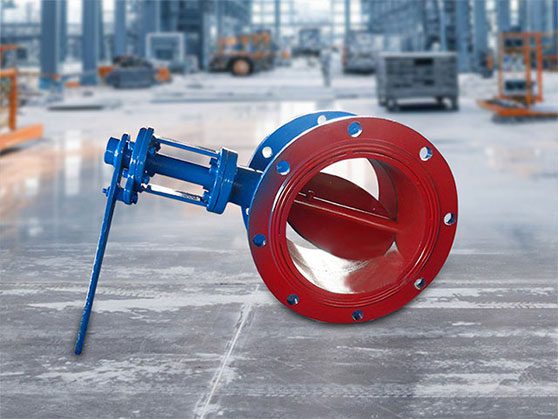Category
A manual butterfly valve is a commonly used control device that easily regulates fluid flow and pressure. It consists of a butterfly plate, valve seat, hand wheel, and other components, making it simple to operate.
Actuation Method: There are two manual actuation methods: handle and turbine. Handle-operated butterfly valves are suitable only for diameters below DN200.
-
Handle-operated manual butterfly valve

| (DN) | Size | ||||||||||||||||
| L | H | H0 | A | B | 0.6MPa | 1.0MPa | 1.6MPa | ||||||||||
| D | D1 | D2 | Z-①d | D | D1 | D2 | Z-①d | D | D1 | D2 | Z-①d | ||||||
| 50 | 108 | 82.5 | 238 | 270 | 65 | 140 | 110 | 88 | 4-14 | 165 | 125 | 99 | 4-18 | 165 | 125 | 99 | 4-18 |
| 65 | 112 | 92.5 | 258 | 270 | 65 | 160 | 130 | 108 | 4-14 | 188 | 145 | 118 | 4-18 | 185 | 145 | 118 | 4-18 |
| 80 | 114 | 100 | 278 | 270 | 65 | 190 | 150 | 124 | 4-18 | 200 | 160 | 132 | 8-18 | 200 | 160 | 132 | 8-18 |
| 100 | 127 | 110 | 293 | 270 | 66 | 210 | 170 | 144 | 4-18 | 220 | 180 | 166 | 8-18 | 220 | 180 | 166 | 8-18 |
| 125 | 140 | 125 | 309 | 310 | 65 | 240 | 200 | 174 | 8-18 | 250 | 210 | 184 | 8-18 | 250 | 210 | 184 | 8-16 |
| 150 | 140 | 142.5 | 336 | 310 | 65 | 285 | 225 | 199 | 8-18 | 285 | 240 | 211 | 8-22 | 285 | 240 | 211 | 8-22 |
-
Turbine-operated manual butterfly valve

| (DN) | Size | ||||||||||||||||
| L | H | H0 | A | B | 0.6MPa | 1.0MPa | 1.6MPa | ||||||||||
| D | O1 | D2 | Z-①d | D | 01 | D2 | Z-①d | 0 | D1 | D2 | Z-①d | ||||||
| 200 | 152 | 164 | 572 | 270 | 280 | 320 | 260 | 2S4 | 8-18 | 040 | 295 | 266 | 8-22 | 340 | 295 | 266 | 12-22 |
| 250 | 165 | 206 | 646 | 270 | 280 | 375 | 265 | C09 | 12-18 | 095 | 390 | 319 | 12-22 | 405 | 395 | 319 | 12-26 |
| 300 | 178 | 230 | 738 | 380 | 420 | 440 | 395 | 363 | 12-22 | 445 | 400 | 370 | 12-22 | 460 | 410 | 370 | 12-26 |
| 350 | 190 | 248 | 761 | 380 | 420 | 400 | 445 | 413 | 12-22 | 605 | 460 | 429 | 16-22 | S20 | 470 | 429 | 18-26 |
| 400 | 216 | 289 | 877 | 450 | 470 | 640 | 495 | 463 | 16-22 | 665 | 616 | 480 | 16-26 | 680 | 626 | 480 | 16-30 |
| 450 | 222 | 320 | 938 | 480 | 490 | 595 | 650 | 518 | 16-22 | 615 | 665 | 630 | 20-26 | 640 | 685 | 548 | 20-30 |
| 500 | 229 | 343 | 993 | 480 | 490 | 645 | 600 | 568 | 20-22 | 670 | 620 | 582 | 20-26 | 715 | 650 | 609 | 20-33 |
| 600 | 267 | 416 | 1131 | 480 | 490 | 755 | 705 | 667 | 20-26 | 760 | 725 | 682 | 20-30 | 840 | 770 | 720 | 20-36 |
| 700 | 430 | 478 | 1476 | 640 | 660 | 860 | 810 | 772 | 24-26 | 895 | 840 | 794 | 24-30 | 910 | 840 | 784 | 24-36 |
| 800 | 470 | 626 | 1633 | 640 | 660 | 976 | 920 | 878 | 24-30 | 1016 | 950 | 901 | 2A-33 | 102b | 950 | 901 | 24-39 |
| 900 | 510 | 585 | 1665 | 750 | 880 | 1076 | 1020 | 978 | 24-30 | 1116 | 1050 | 1001 | 28-33 | 1126 | 1060 | 1001 | 28-39 |
| 1000 | 550 | 640 | 1765 | 850 | 900 | 1175 | 1120 | 1078 | 28-30 | 1230 | 1160 | 1112 | 28-36 | 1256 | 1170 | 1112 | 28-42 |
| 1200 | 630 | 755 | 1995 | 850 | 900 | 1405 | 1340 | 129S | 32-33 | 1465 | 1080 | 1328 | 32-39 | 1486 | 1390 | 1328 | 32-48 |
| 1400 | 710 | 910 | 2310 | 1000 | 925 | 1630 | 660 | 1610 | 36-36 | 1676 | 1690 | 1530 | 06-42 | 685 | 1590 | 1630 | 36-48 |
| 1600 | 790 | 1030 | 2595 | 1000 | 925 | 1830 | 1760 | 1710 | 40-36 | 1916 | 1820 | 1760 | 40-48 | 1930 | 1850 | 1750 | 40-56 |
| 1800 | 870 | 1140 | 2810 | 1100 | 980 | 2045 | 1970 | 918 | 44-39 | 2115 | 2020 | 1950 | 44-48 | 2130 | 2020 | 1950 | 44-56 |
| 2000 | 950 | 1260 | 3100 | 1100 | 980 | 2265 | 2180 | 2125 | 48-42 | 232S | 2230 | 2160 | 48-48 | 2345 | 2230 2160 48-62 | ||
Connection Type: Common connection types for butterfly valves include wafer type and flange type.
Differences Between Manual Flange Butterfly Valve and Wafer Type Manual Butterfly Valve
Connection Method
Manual flange butterfly valves connect using flanges, while wafer type manual butterfly valves connect using wafer connections. In addition, flange connections suit high-demand applications, such as high temperature and high pressure. On the other hand, wafer connections work better in situations with limited temperature and pressure.
Applicable Range
Manual flange butterfly valves typically serve applications that require high sealing and discharge capabilities. In contrast, wafer type manual butterfly valves work better for fluid control. These valves excel in situations where temperature and pressure requirements are less stringent.
Vibration Resistance
Wafer type manual butterfly valves have strong vibration resistance, making them particularly suited for environments prone to vibrations and impacts. In this regard, manual flange butterfly valves do not perform as well.
Highlights of Wafer Type Manual Butterfly Valves
Wafer type manual butterfly valves, which utilize a wafer connection, have the following characteristics:
Simple Installation
The wafer connection allows for easy installation, disassembly, and replacement. The strong clamping force prevents loosening due to pipeline vibrations and temperature changes.
Strong Vibration Resistance
Manual butterfly valves are widely used in environments with frequent vibrations, impacts, and pressure shocks, providing excellent vibration resistance.
Wide Applicability
Manual butterfly valves are suitable for controlling low-temperature and low-pressure liquid fluids, as well as low-pressure gases.
Highlights of Manual Flanged Butterfly Valves
Manual flange butterfly valves, which use flange connections, have the following benefits:
Easy Installation
Manual flange butterfly valves require only flange connections during installation. As a result, they eliminate the need for further preparatory work, saving both time and labor costs.
High Sealing Performance
These valves offer excellent sealing capabilities, making them suitable for high-demand applications.
Convenient Discharge
Manual flange butterfly valves can be equipped with reliable discharge facilities, facilitating the discharge of high-temperature and high-pressure fluids.


